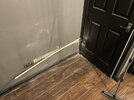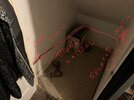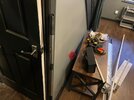Hi, so my daughter wanted a socket in the living room on the side of the stairs no problem I says hmm , but it’s not built how I imagined and the floor is concrete.
I’ve chased a channel from the nearest socket and fed a cable through trunking to the under stairs back wall dot and dab ( it is a ring) my idea was fit a fuse spur and a double socket under the stairs ( she has a rechargeable vacuum) then external trunking around the inside of the under stairs. Although I might skip the fuse and socket. Can’t think how to get the cable out if I do that. I can’t think of another way other than trunking. Because that exterior wall is so thin. Also no idea wats behind the latter at the end of the stairs.
The “wall” where she wants the socket appears to just be double thick plasterboard, to be honest not really sure what it is so I was going to mount a surface mount double socket on the exterior just pushed through the wall behind the trunking.
Is there a better way to this?
Thanks in advance.
I’ve chased a channel from the nearest socket and fed a cable through trunking to the under stairs back wall dot and dab ( it is a ring) my idea was fit a fuse spur and a double socket under the stairs ( she has a rechargeable vacuum) then external trunking around the inside of the under stairs. Although I might skip the fuse and socket. Can’t think how to get the cable out if I do that. I can’t think of another way other than trunking. Because that exterior wall is so thin. Also no idea wats behind the latter at the end of the stairs.
The “wall” where she wants the socket appears to just be double thick plasterboard, to be honest not really sure what it is so I was going to mount a surface mount double socket on the exterior just pushed through the wall behind the trunking.
Is there a better way to this?
Thanks in advance.




